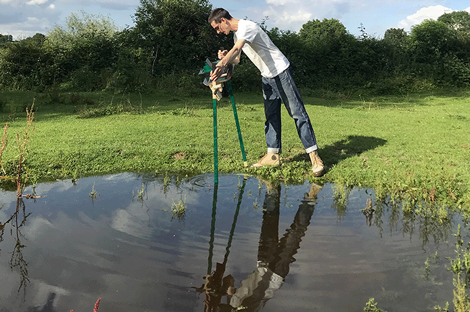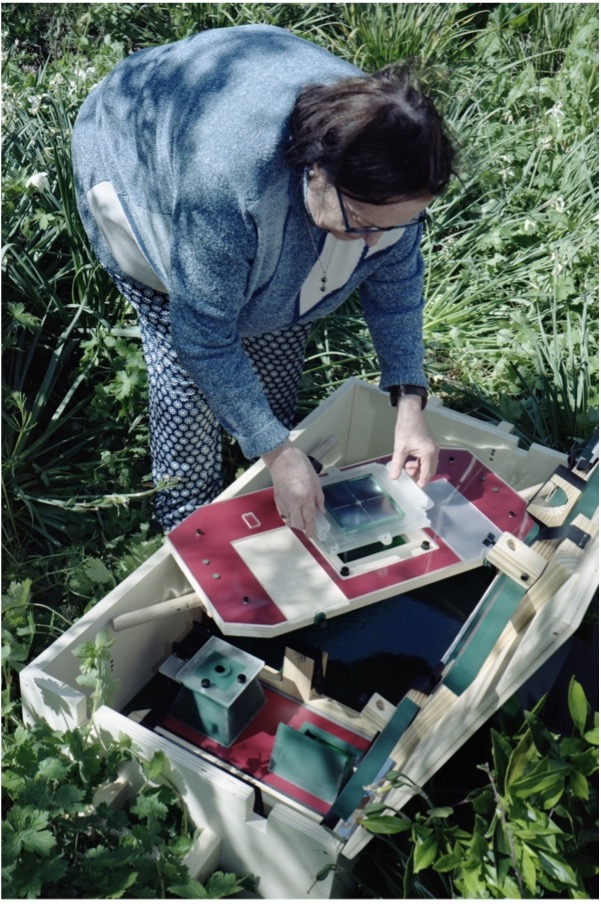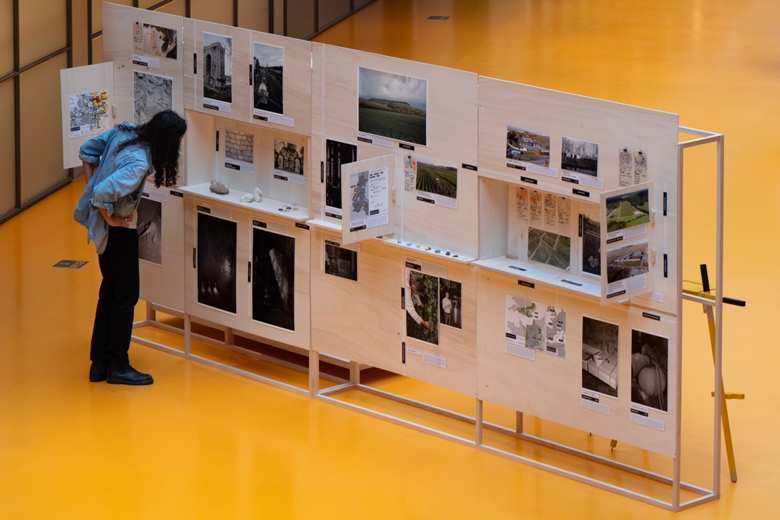
Prototyping interaction towards shared landscape cultures par Olivier TROFF
From the doctoral research entitled "Popular landscape cultures in design: mediation and interaction" on the prototyping of observation methods and instruments dedicated to the collective documentation of the landscape from the ground.
Blanks in knowledge in design
The ever-increasing amount of information available about landscapes, as well as their increasingly advanced degradation, curtail the possibilities to conduct structured studies about the domestication of those territories. Studies that could gather, all at once, order and disorder, the past, the present and the speculative near future, uncertainty, contradiction and invention. The knowledge of the landscape is torn into a multitude of dimensions of reality, each one providing knowledge and experiences that supports its understanding in a deeper, but rarely more general and discerning way.
Regarding this, mediation conducted by landscape researchers most of the time uses conventional surveying tools such as mapping or modelling – considered collaboratively. While there is not proper consideration about the design of the tool in itself, in the design discipline, that topic often remains contained to strictly sensitive observation devices or to citizen science based on sensors. Nonetheless, design could go further as it is accustomed to work at the intersection of various disciplinary fields to merge them together. Designers have the capacity to articulate and manage the connections between heterogeneous knowledges, practices and value systems. Such as the paradigmatic film on that topic, Powers of Ten, directed in 1977 by Charles and Ray Eames for IBM. Are articulated scientific representations of the infinitely large and the infinitesimally small in a same sequence, by zooming out and in the scenery of a lunch in a park in some North-American metropolis. This is a way of metrically accounting for realities studied by distinct scientific disciplines, usually separated in scientific objects – however all related under the guise of the actual life.
Designing relations
Secondly, articulation of knowledge regarding changing landscapes can be tackled by interaction design in itself as a way to prototype relations between people and spaces through methods and artefacts. One should also remember that the common term of “mediation” refers to media, i.e. a system that connects something radically different from one another. In addition to this, “mediation” also refers to medium, in the sense of a technic and the materiality of it. As a consequence, considering landscape mediation through artefacts, technic and their related environments, in design, seems to be a promising perspective of research. Yet in a fairly different context at the borders of performance, activism and design dedicated to antiracism, the artist and designer Krzysztof Wodiczko already addressed that topic with the Alien Staff project as from 1992. Alien staff is an relational object that connects the former and the new world of an exile. During the performance, the exile approaches people in the street, with the totemic staff in his or her hand, and tell them about their journey. Alien staff is a mediating object in the sense that it allows interaction: it brings together two people for whom difference is important and contact requires a design to happen. Because of its stature, the staff produces a situation that favours consideration and tacit sharing of knowledge and experiences.

Cam·obs: kit and case, 2023
Setting up an on-site laboratory
Considering landscape mediation through interaction design allows to focus on the design of methods and novel artefacts reconfiguring relation, and the actions related to it, instead of questioning the topic in terms of participation. The previous examples shows that pacing and guiding, probing and finally articulating are key actions. It questions how to step in various, sometimes unknown, unsettling rural or urban landscapes. How to probe the territory in a qualitative way with devices that both reveals hidden dimensions of the landscape and divergent knowledge and experiences people may have about it. And finally, how to merge this knowledge towards a shared and lifting understanding of processes of domestication of those spaces.
To do so, one of the interaction artefact prototyped during this research is based on the ancient optical principle of the camera obscura. It was redesigned as a relational artefact dedicated to landscape documentation through the lens of the ground. Ground can be understood both as a material base of human settlements as well as surface considered as a “piece of evidence”. The transdisciplinary study of it would open up to a potentially amplified understanding of the discrete but nonetheless significant dimensions of time and space existing at the scale of landscape. With the cam·obs, group fieldwork plans on rearranging people and knowledge through a common work where it is necessary to talk and draw together; where the relational instrument makes converge a collaborative and situated knowledge; where the landscape is discussed on how people works, studies, perceives and inhabits it. In addition to this, that relational device must be considered as a vehicle for laying the foundations of a more general landscape studies practice devoted to the design of methods for documenting landscapes having strong cultural and environmental backgrounds. The project could thus be adapted and implemented in different places.
Experiments
The project has already been tested in various situations such as in a rural landscape in Avesnois bocage in the North of France. In the intensive productive context of the vineyards of Champagne where the well-known sparkling wine is produced. And in the metropolitan area of Gennevilliers located in the North-Western suburbs of Paris. Initial fieldwork in Avesnois allowed to test the visual relation the cam·obs provokes between people and ground through the very specific texture of the optical image. Its immersive qualities allow to enter a specific scale of the landscape while enhancing colors, textures and overall quality of attention paid to details. Equipped with interchangeable viewfinders, the cam·obs also permits the observers to micro-map the ground through schematic drawing. In addition to this, various prototypes were built to test how the artefact would lead the participants to pace the terrain in specific ways: one was equipped with a tripod that could be removed to be entirely transported on shoulders while another one was a “walking” cam·obs designed to trigger sympathy and mutual help between the persons involved.

Exhibition view, “In the light of Limestone”, study about domestication of the vineyard landscape in Champagne, 2021-2023.
Champagne was chosen as a second context of experimentation. In that area is made an evocative and luxurious sparkling wine, whose production is based on an industrial, artisanal and heritage system in a region where agricultural practices are evolving rapidly due to climate change. The research aimed at testing how landscape surveying focus on the ground was able to generated a specific as well as unsiloed type of knowledge. Extensive fieldwork includes interviews with wine producers, researchers, inhabitants, study of grounds by micro-mapping with cam·obs, documentation of the general form of landscape and places, people and technics of wine production by analogue photographic cameras and drone. While gathering a variety of medias and viewpoints in a single landscape study, that experiment especially focuses on how the make available the knowledge created to designers. It reveals how the liminal dimension of limestone in Champagne is traceable from the very beginning of the geological history of the region to the latest developments of champagne production in terms of technics involved, symbolism and general form of landscape. It also reveals how limestone is part of a domestication process, leading to a fairly preoccupying environmental situation and how understanding it may reopen to sustainable and speculative ways of working with the landscape. Eventually, experiments in Gennevilliers intended to test how knowledge and people with divergent backgrounds and value system could tacitly circulate by using the cam·obs. To do so, a series of workshops was organised, gathering inhabitants, researchers, professionals, a public company and local elected representatives. Called “Rediscovering your everyday landscape, a journey…”: the first one “…to the future of materials” is an exploration of the Port of Paris. While the second one “…to the infinitesimally small” deals with macro-fauna and flora observation, and the third one “…60 million years ago” is an historical journey throughout the geology of a Loop of the river Seine. Focusing on very specific areas, scales or objects, the workshops showed how knowledge is able to tacitly circulate between participants and, in the same time, always be related to the tangible general form of the city landscape.



